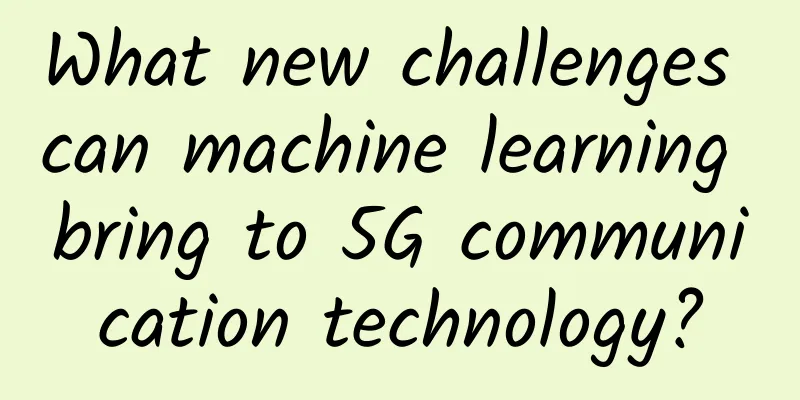What new challenges can machine learning bring to 5G communication technology?

|
Wireless communication now plays an important role in our daily lives. The latest 5G network communication aims to provide faster, more reliable and more efficient data transmission speeds and services than the existing 4G network. At the same time, the rapid development of artificial intelligence in recent years has provided new methods and opened up new opportunities for solving difficult problems in traditional communication technologies. This paper introduces the application of machine learning in 5G advanced wireless communication based on the research progress of machine learning, a classic technology in the field of artificial intelligence, and further explores the challenges and future research directions of the application of machine learning in 5G advanced wireless communication. 1. Introduction to 5G network communication 5G network, the fifth generation of mobile communication technology, is the core of the new generation of mobile communication technology. 5G has ultra-high spectrum utilization and energy efficiency, and its transmission rate and resource utilization are at least one order of magnitude higher than 4G mobile communication. Its wireless coverage performance, transmission delay, system security, etc. are also significantly improved. 5G mobile communication is closely integrated with other wireless mobile communication technologies to form a new generation of ubiquitous mobile information network. It can meet the development needs of mobile Internet traffic increasing 1,000 times in the next 10 years [1]. In addition, the application areas of 5G mobile communication systems have also been further expanded. Its application in the fields of intelligent transportation, telemedicine, Internet of Things, virtual reality entertainment, etc. has brought unprecedented convenience to people's lives. At the same time, 5G communications still face many challenges. For example, due to the high speed and large capacity of 5G networks, higher requirements are placed on network equipment and information transmission technology; 5G networks have the characteristics of flexibility and adaptability, but their security and stability require more technological innovation to ensure, etc. 2. Introduction to machine learning technology With the development of artificial intelligence technology, new ideas have been provided for difficult problems that cannot be solved by traditional methods. As a major branch of artificial intelligence technology, machine learning solves complex problems by learning from previous data and extracting features. Machine learning is mainly divided into three branches: supervised learning, unsupervised learning, and reinforcement learning. Figure 1 illustrates the relationship between artificial intelligence (AI), machine learning (ML), supervised learning, unsupervised learning, and reinforcement learning. Supervised learning learns the corresponding mapping model by using labeled training data sets. Deep Neural Network (DNN) is a typical representative of supervised learning. It obtains the convergence weight coefficients of multi-layer artificial neural networks through offline training and infers new data. Unlike supervised learning, unsupervised learning uses unlabeled training data sets to obtain mapping models. In the classic autoencoder structure, the network coefficients are adjusted to restore the true value of the input data by learning the inherent characteristics of the input data. Reinforcement learning is based on the dynamic interaction between the agent and the external environment, and can process data online. The agent learns by exploring the environment and rewarding or punishing actions, and optimizes the cumulative reward with the best action sequence. Figure 1: The relationship between artificial intelligence, machine learning, supervised learning, unsupervised learning, and reinforcement learning 3. Application of machine learning in 5G communications In recent years, researchers around the world have shown great interest in using machine learning to develop 5G communication technology. Next, we will focus on several applications of machine learning in 5G wireless communications. 3.1 Adaptive modulation encoding (AMC) AMC is an adaptive coding and modulation technology used in wireless channels. It ensures the transmission quality of the link by adjusting the modulation mode and coding rate of the wireless link transmission. However, in actual applications, the current AMC technology is too complex due to inaccurate model-based approximation or too large a size of the lookup table, and does not show good performance. Since AMC is a typical classification problem, supervised learning in machine learning has naturally become an important choice for optimizing adaptive modulation and coding technology. The most commonly used supervised learning algorithm to solve this problem is the K-NN (K Nearest Neighbors) algorithm, which works on the principle that when predicting a new value X, it determines which category x belongs to based on the type of the K points closest to it. For example, in Figure 2, when judging the type when k=3, we observe that there are two triangles and one square among the three adjacent points, so we judge that the type of k=3 is a triangle. Figure 2: K-NN algorithm example However, the biggest difficulty of the K-NN algorithm is that it cannot clearly define the class boundaries [2] and requires a large offline training database. In contrast, reinforcement learning can learn directly from the environment. Therefore, people try to use Markov process reinforcement learning to implement AMC, which has higher adaptability than the K-NN algorithm. 3.2 Channel Equalization Technology Channel equalization is an anti-fading measure taken by the communication system to improve the transmission performance of the fading channel, mainly to eliminate the problems of inter-symbol interference and nonlinear distortion. Its principle is to compensate according to the characteristics of the channel or the entire transmission system. For example, Figure 3 shows the channel equalization technology that adjusts the transmission power according to the channel quality. Since machine learning can achieve the ability of adaptive signal processing, people have proposed machine learning-based equalizers to improve the characteristics of traditional equalizers. Based on the fact that machine learning can extract the key features of time-varying wireless channels, an adaptive equalizer based on multilayer perceptron (MLP) is proposed, which is mainly used for inter-symbol interference (ISI) suppression of linear channels. Later, based on the MLP equalizer, people proposed a recursive neural network equalizer based on FLANN. Through its ability to simulate nonlinear filters, it is used to equalize complex signals with nonlinear channel distortion, and has low computational complexity. Figure 3: Channel equalization technology that adjusts transmit power based on channel quality 3.3 Load Forecasting Since the frequency of 5G wireless networks is much higher than that of 4G, and the higher the frequency of the base station, the faster the attenuation will be, more 5G base stations need to be deployed to cover the same area as 4G. Therefore, overcoming the energy consumption caused by base station density through load prediction has also become a key issue. Over the years, machine learning has been widely used in load forecasting. A variety of machine learning algorithms can be used. The autoregressive integrated average model is a simple load forecasting method that has been widely used; the Prophet model uses time series analysis to achieve predictions and can also be used for load forecasting; long short-term memory (LSTM) is a multi-memory unit structure based on RNN, which is suitable for load forecasting. Ensemble learning (EL) can combine multiple models in a linear manner to generate an integrated model with strong predictive ability. Each ML algorithm has its own advantages and disadvantages. Therefore, the most suitable machine learning algorithm for load forecasting needs to be determined according to different application goals. 4. Challenges and future directions Although machine learning has been widely used in many technologies of 5G communications, there are still some problems and challenges, such as: ①Current machine learning methods all require a long convergence time, which limits their application in dynamic wireless communications. Therefore, further research is needed to accelerate the convergence process of machine learning. ② Due to the time-varying characteristics of wireless channels, machine learning parameters and even machine learning methods need to be constantly adjusted, which greatly increases the complexity of the communication system. Therefore, it is necessary to conduct in-depth research on unified machine learning methods for different applications. ③Currently, most machine learning methods require a large amount of labeled data to achieve model learning and training, but most of the data generated by wireless networks are unlabeled raw data. Therefore, the labeling of raw data needs further research and improvement. References: [1] You Xiaohu, Pan Zhiwen, Gao Xiqi, et al. Development trend and key technologies of 5G mobile communication[J]. Scientia Sinica: Information Sciences, 2014, 44(5):551-563. DOI:10.1360/N112014-00032. [2] Y. Zhou, J. Chen, M. Zhang, D. Li and Y. Gao, "Applications of Machine Learning for 5G Advanced Wireless Systems," 2021 International Wireless Communications and Mobile Computing (IWCMC), Harbin City, China, 2021, pp. 1700-1704, doi: 10.1109/IWCMC51323.2021.9498754. |
<<: Corn's origins have been updated: It turns out it has two "ancestors"
Recommend
The Internet of Things is here, but mobile phones won’t disappear
[[126240]] At this year's CES, Chinese manufa...
Domestic H5 development: Sunflower realizes H5 WeChat remote control and provides a new path for embedded development
Recently, the domestic remote control brand Sunfl...
The Mid-Autumn Festival and National Day are approaching. How do major brands do marketing?
It is said that there are less than 100 days left...
Yang Jingkun: "Play with short videos with your phone and shoot cool Vlogs with zero basics"
Yang Jingkun's resource introduction of "...
Old School Seo: Baidu Domination Course "Search Engine Promotion System Can Be Replicated to Build a Precise Passive Traffic System" with Tools
Old-school Seo: Baidu screen domination and traffi...
OPPO K9 Pro mobile phone review: hot appearance and cool core, a great value "light flagship" choice
Today's mobile phone market has fallen into a...
How to build a user “retention” system?
In order to attract more users, many companies ar...
NBA basketball teaching_professional basketball teaching_NBA basketball teaching video_nba shooting teaching video
NBA basketball teaching_professional basketball t...
When will the cell phone “bombs” end?
Nowadays, smartphones have become an important to...
Youzi video account sells health tea with zero basic operation and earns more than 10,000 yuan a month
Youzi video account brings goods to the market an...
Master these 10 design theories to help you make experience designs that are easier to pass
A good design should not only solve the right pro...
28 thoughts on marketing, operations, copywriting, and new media!
1 What is a brand? It seems that there are very f...
This year's new trend! Make tassel earrings out of plants!
Recently, a plant that can be used as "tasse...
8 sets of information flow advertising ideas + 2 types of combination targeting, Get it! | Gaming Industry
Among Baidu's information flow resources, Bai...
The U.S. Navy accelerates unmanned production and produces the second Stingray to provide air support for the E-2D
On August 18, 2021, a U.S. Navy E-2D Hawkeye airc...









